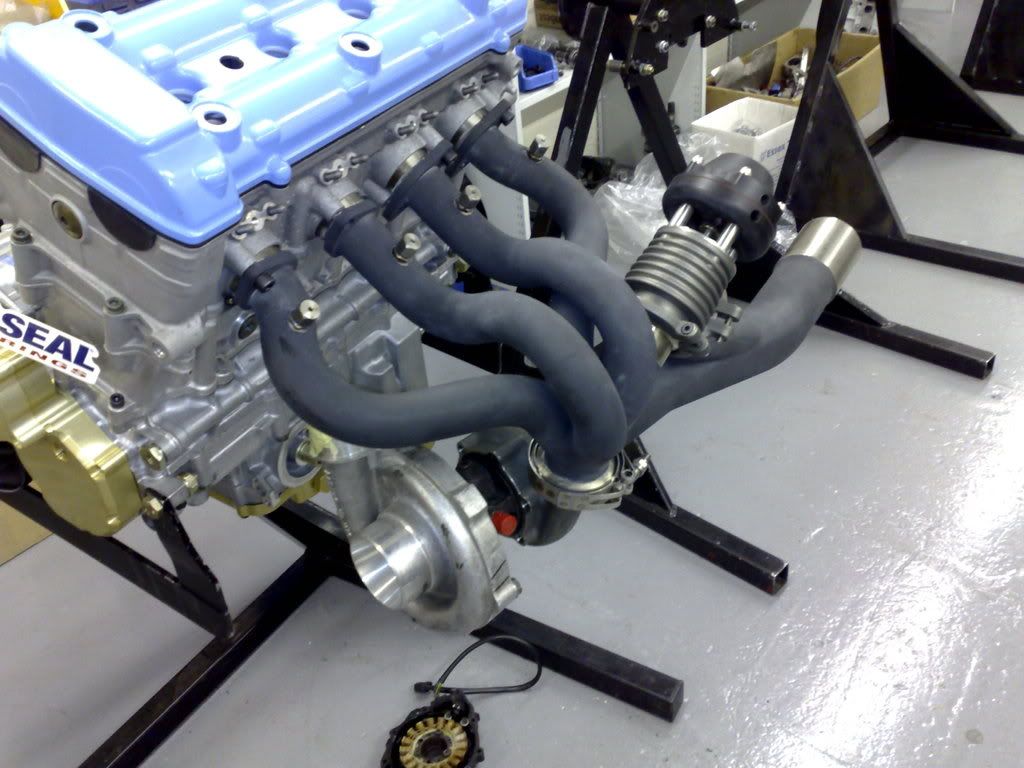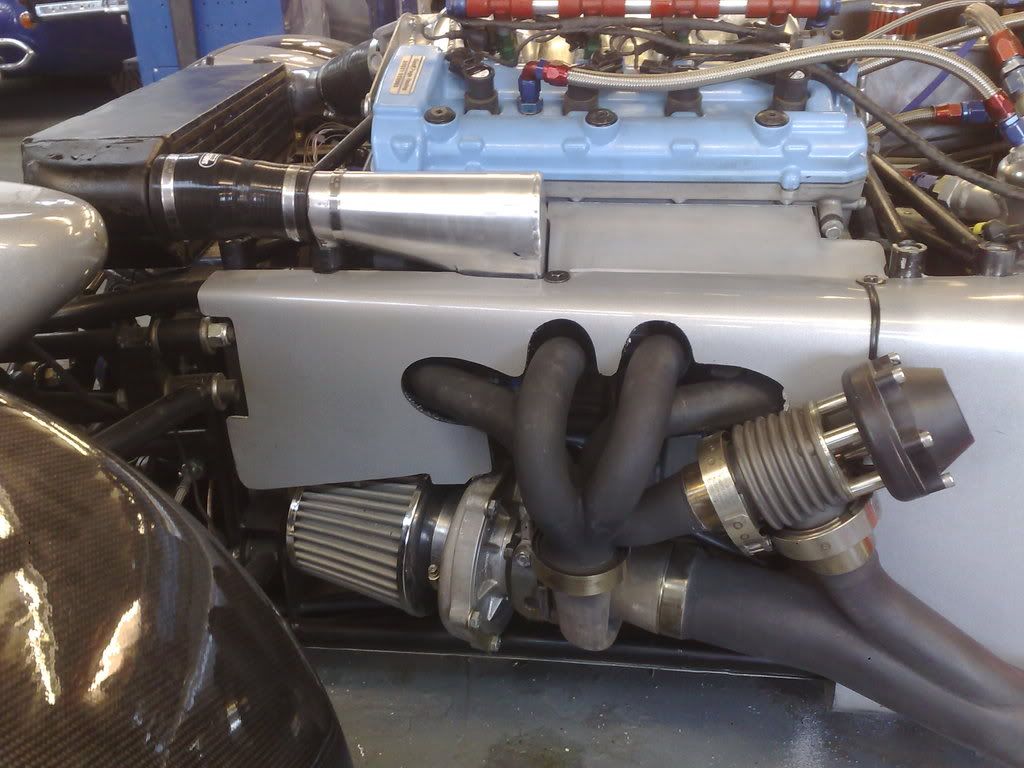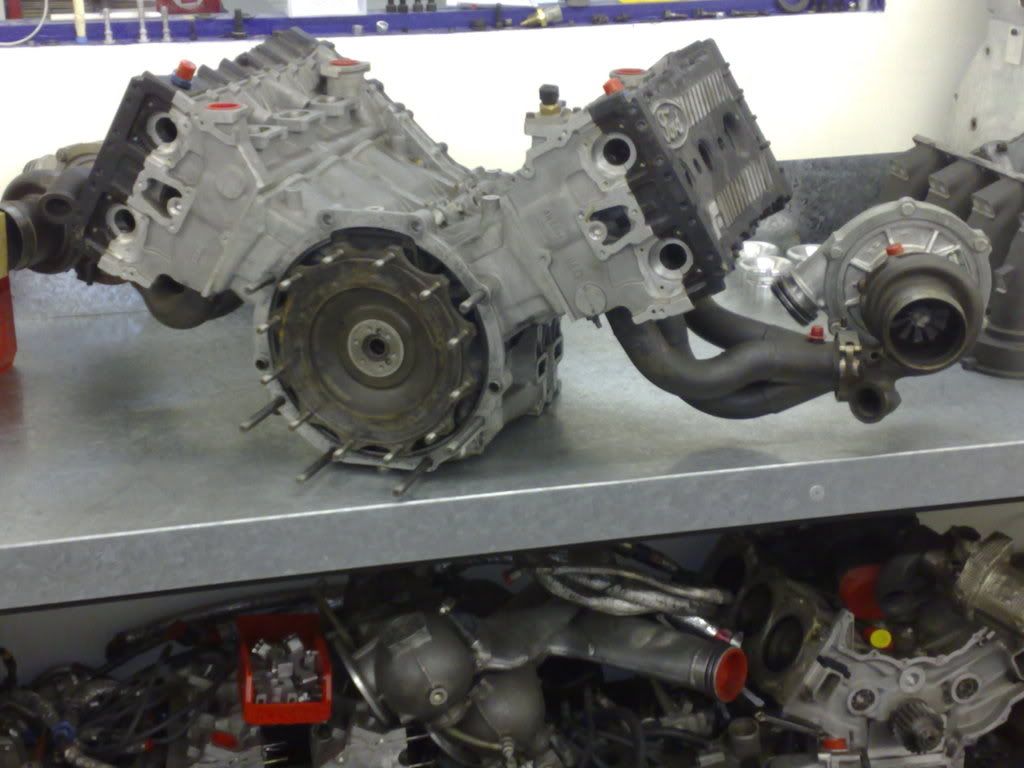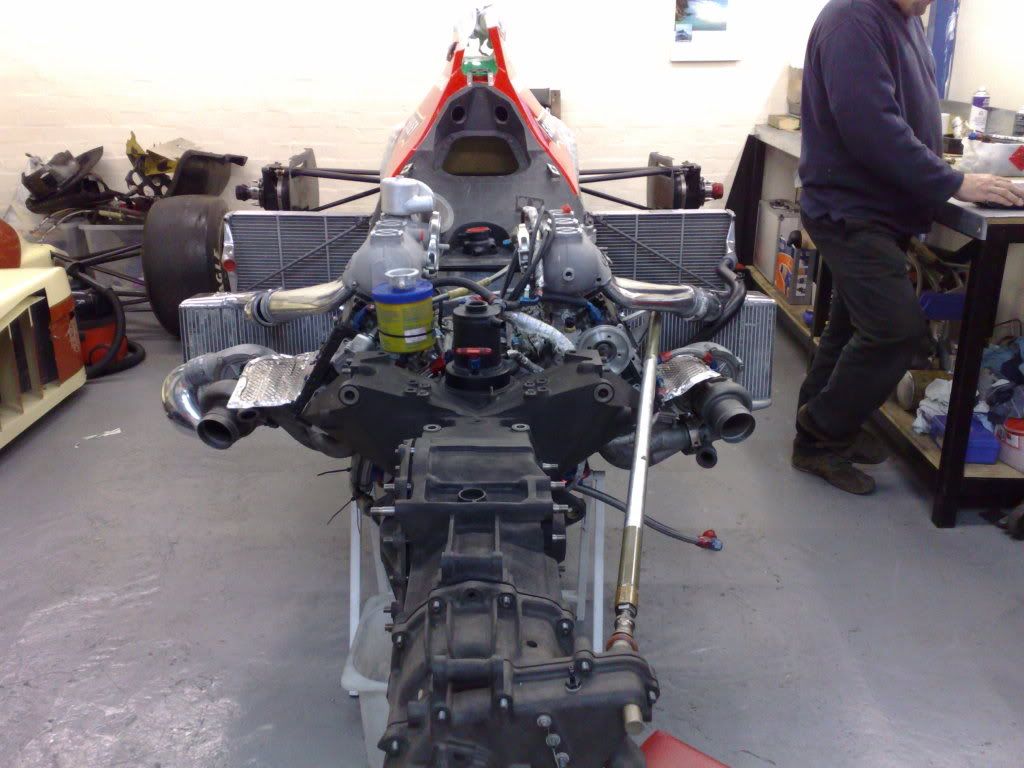F1 Turbo Engines
Discussion
A question for someone technical on all things turbo related.
As someone who has dabbled in car modifying including turbo engines, I'm struggling to understand how the 1.5L turbo F1 engines achieved such high power and boost levels.
Am I correct in thinking turbos have a point in which they cannot provide more boost? Even top aftermarket turbochargers (20 years on) seem to max out at 2 - 2.5Bar whereas I've read the BMW F1 Turbo could muster 5 Bar for quali!! All this in the 80s for heavens sake.
So what what the secret? How where they drivable? They must have had mega turbo lag but they dont appear to be too bad from the TV footage. Being light must have helped, no?
I just cant get my head around it!
As someone who has dabbled in car modifying including turbo engines, I'm struggling to understand how the 1.5L turbo F1 engines achieved such high power and boost levels.
Am I correct in thinking turbos have a point in which they cannot provide more boost? Even top aftermarket turbochargers (20 years on) seem to max out at 2 - 2.5Bar whereas I've read the BMW F1 Turbo could muster 5 Bar for quali!! All this in the 80s for heavens sake.
So what what the secret? How where they drivable? They must have had mega turbo lag but they dont appear to be too bad from the TV footage. Being light must have helped, no?
I just cant get my head around it!
compocon said:
A question for someone technical on all things turbo related.
As someone who has dabbled in car modifying including turbo engines, I'm struggling to understand how the 1.5L turbo F1 engines achieved such high power and boost levels.
Am I correct in thinking turbos have a point in which they cannot provide more boost? Even top aftermarket turbochargers (20 years on) seem to max out at 2 - 2.5Bar whereas I've read the BMW F1 Turbo could muster 5 Bar for quali!! All this in the 80s for heavens sake.
So what what the secret? How where they drivable? They must have had mega turbo lag but they dont appear to be too bad from the TV footage. Being light must have helped, no?
I just cant get my head around it!
No they dont, there are plenty of turbos that can easily run very high boost pressures.As someone who has dabbled in car modifying including turbo engines, I'm struggling to understand how the 1.5L turbo F1 engines achieved such high power and boost levels.
Am I correct in thinking turbos have a point in which they cannot provide more boost? Even top aftermarket turbochargers (20 years on) seem to max out at 2 - 2.5Bar whereas I've read the BMW F1 Turbo could muster 5 Bar for quali!! All this in the 80s for heavens sake.
So what what the secret? How where they drivable? They must have had mega turbo lag but they dont appear to be too bad from the TV footage. Being light must have helped, no?
I just cant get my head around it!
In the 80's, it was a free for all. The technology was there and ever improving, and the fuel was there.
Today modern performance engines are strangled by rules and regulations.
compocon said:
I see, I didnt realise that. Cheers
Can you give an example of a turbo that can flow +500bhp at over 3 Bar?
I've never come across one that's all
unless its a 1000cc engine, its unlikely you would ever get a situation where you would require 3 bar and 500bhp.Can you give an example of a turbo that can flow +500bhp at over 3 Bar?
I've never come across one that's all

but yes, there are motorbike engines out there making over 500bhp, and using silly levels of boost to achieve it.
Basically, the geometery of a centrifugal compressor is optimised for both the pressure ratio and the mass flow that it has to pump against. So, the blade number, angle, inducer/exducer dia, rpm, and expansion scroll are simply optimised for high boost rather than low boost. 5 bar is nothing for an industrial centrifugal compressor! (you can easily get well over 10bar pressure ratio) What is crucial however is the blade to housing clearance, because as the pressure ratio increases, the mass flow that "escapes" by falling between the gap (between end of compressor blade and the housing inner profile) becomes significant. On a hand built "race" turbo you can run very tight clearances here without too many problems (as compared to haveing to make several million turbos like your average garrett device for example, although "abraidable" coatings have helped in this respect)
Also, it's the "pressure ratio" that sets compressor work and efficiency, not the outlet pressure, so a modern road turbo diesel, which runs with 2bar gauge outlet pressure, might, with a dirty airfilter (that now has to do 20kmiles etc!) and a pre-compressor system designed for quietness (to get through driveby noise test) only have 50kpa abs precomp pressure at WOT, and so have a pressure ratio of 4. Compared to the F1 turbo, 5bar gauge out, 0.95 bar abs in, pressure ratio of 5.26, so oly 30% bigger than your boggo tdi repmobile !!(and F1 car might even get a positive pre turbo pressure from dynamic ram at high vehicle speeds!!)
An F1 era 1.5l turbo engine does have a pretty narrow power band, approx a usable range of only 1500rpm! which made them dam hard to drive (11krpm = 300bhp, 11.5krpm = 900bhp!!)
and as for the power potential, its helped by having the volumetric efficiency optimised to peak at high rpms (typically 11 to 13krpm) Most "aftermarket" big boost turbo's are all shot at somewhere between 6500 and 7500rpm
Also, it's the "pressure ratio" that sets compressor work and efficiency, not the outlet pressure, so a modern road turbo diesel, which runs with 2bar gauge outlet pressure, might, with a dirty airfilter (that now has to do 20kmiles etc!) and a pre-compressor system designed for quietness (to get through driveby noise test) only have 50kpa abs precomp pressure at WOT, and so have a pressure ratio of 4. Compared to the F1 turbo, 5bar gauge out, 0.95 bar abs in, pressure ratio of 5.26, so oly 30% bigger than your boggo tdi repmobile !!(and F1 car might even get a positive pre turbo pressure from dynamic ram at high vehicle speeds!!)
An F1 era 1.5l turbo engine does have a pretty narrow power band, approx a usable range of only 1500rpm! which made them dam hard to drive (11krpm = 300bhp, 11.5krpm = 900bhp!!)
and as for the power potential, its helped by having the volumetric efficiency optimised to peak at high rpms (typically 11 to 13krpm) Most "aftermarket" big boost turbo's are all shot at somewhere between 6500 and 7500rpm
Edited by anonymous-user on Wednesday 22 September 21:43
Should also add that "Inlet restricted" turbo's (a-la WRC, Le Mans etc) are a right PITA for compressor work. An orifice goes "critical" (the point where any decrease in downstream pressure does not result in any increase in massflow through that orifice) at 58% of the upstream pressure. So, for 1 bar abs intake pressure, a choked intake restrictor (and you gota choke it or you aint getting max airflow!!) will have only 58kpa abs downstream, and because those canny rule makers specifiy the maximum distance between the restrictor and the compressor inducer (50mm for wrc) you cannot engineer a nice shape to maximise pressure recovery, which can limit precompressor pressure to as little as 70kpa. So wrc engine at peak torque, can run with pressure ratio's up to 6, which is why a TR30R turbo costs over £7k !!!
Impressive info Max Torque, even if I dont understand most of what you're saying!
So bringing this to present day amatuer motorsport, it seems most people stick big turbos on their engines and have lag during gearchanges.
Would it be more benificial to obtain a smaller turbo, more specialised turbo and run at high boost instead?
Or is it not as simple as that/too many variables
What's the downside to high boost vs bigger turbo? Charge temperature?
So bringing this to present day amatuer motorsport, it seems most people stick big turbos on their engines and have lag during gearchanges.
Would it be more benificial to obtain a smaller turbo, more specialised turbo and run at high boost instead?
Or is it not as simple as that/too many variables
What's the downside to high boost vs bigger turbo? Charge temperature?
Of course the best turbo to fit is the most efficient one that is "sized" to provide the torque curve you want! Turbo efficiency really is important because of the numerous "knock on effects", for example:
Say you want to make 2 bar gauge boost pressure, at an intake mass flow of 0.3kg/s, turbo A has 85% compressor efficiency at that operating point turbo B only 65%
(for both cases ambient temp = 25degC, ambient pressure = 1bar abs)
Case A: Compressor work = 39kW, air out of compressor temp = 154.3 degC
Case B: Compressor work = 50.1kW, air out of compressor temp = 194.1 degC
to get a plenum temp of a sensible 40degC requires an aftercooling system effectiveness of 88% for case A, and 92% for case B
In order to furnish the extra compressor work in case B, more energy will have to be removed from the exhaust gas stream, which bumps up pre-turbine pressure (and temperature due to the under expansion), this reduces engine manifold volumetric efficiency (as the engines pressure ratio is now less favourable) so to get back to the same airflow for caseB would actuall require more boost pressure, but, more boost pressure = more work, more work = more energy from exhaust..... etc etc etc, Basically you get into a nasty downward spiral. and thats before you have even considered the possible effects of increased charge temps on ignition retard (and then the extra fuel you need to stick in to stop things melting etc)
An F1 turbo engine sat in that rare area where the engine had a positive pressure ratio, i.e. the boost pressure was ABOVE the pre-turbine exhaust pressure, and suddenly, not only does your turbo increase charge density (which is ALL it does on a more typical engine, as it actually reduces manifold volumetric efficiency),but it also is able to increase mass flow, and mass flow = power!
(typical turbo engines have pre-turbine exhaust pressures of between 2x and 3x plenum boost pressure)
regarding gear shift lag, the trick is to opimise your gear system so you do not have to shut the throttle to shift, and infact "spark cut" or "spark retard" systems can be very effective in minimising lag post shift as they send a huge burst of energy straight out the exhaust ports,
Boost threshold (the engine rpm at which the "gain" of the turbo system exceeds 1)(i.e. more boost = more massflow = more exhaust energy = more boost) is faily easily avoided by using the correct gearing, especially for race cars which have a fairly controlled environment (ie. you know before the race what sort of hairpins / starts etc you are going to have to do) (more of an issue with rally cars due to the wider environmental range these cars run under, hence all the "anti-lag" strategies etc)
General "throttle lag" or non-linearity, is more of an issue for a race car, say if you have to lift off the throttle to maintain (or alter) the dynamic chassis balance, then there will be a delay and non-linearity in the torque response upon re-application of the throttle. Again, depending upon the circuit / track / stage, a balance will be found between response and absolute power that gives the fastest lap time (very very driver / setup dependant, in most cases more power = faster)
Say you want to make 2 bar gauge boost pressure, at an intake mass flow of 0.3kg/s, turbo A has 85% compressor efficiency at that operating point turbo B only 65%
(for both cases ambient temp = 25degC, ambient pressure = 1bar abs)
Case A: Compressor work = 39kW, air out of compressor temp = 154.3 degC
Case B: Compressor work = 50.1kW, air out of compressor temp = 194.1 degC
to get a plenum temp of a sensible 40degC requires an aftercooling system effectiveness of 88% for case A, and 92% for case B
In order to furnish the extra compressor work in case B, more energy will have to be removed from the exhaust gas stream, which bumps up pre-turbine pressure (and temperature due to the under expansion), this reduces engine manifold volumetric efficiency (as the engines pressure ratio is now less favourable) so to get back to the same airflow for caseB would actuall require more boost pressure, but, more boost pressure = more work, more work = more energy from exhaust..... etc etc etc, Basically you get into a nasty downward spiral. and thats before you have even considered the possible effects of increased charge temps on ignition retard (and then the extra fuel you need to stick in to stop things melting etc)
An F1 turbo engine sat in that rare area where the engine had a positive pressure ratio, i.e. the boost pressure was ABOVE the pre-turbine exhaust pressure, and suddenly, not only does your turbo increase charge density (which is ALL it does on a more typical engine, as it actually reduces manifold volumetric efficiency),but it also is able to increase mass flow, and mass flow = power!
(typical turbo engines have pre-turbine exhaust pressures of between 2x and 3x plenum boost pressure)
regarding gear shift lag, the trick is to opimise your gear system so you do not have to shut the throttle to shift, and infact "spark cut" or "spark retard" systems can be very effective in minimising lag post shift as they send a huge burst of energy straight out the exhaust ports,
Boost threshold (the engine rpm at which the "gain" of the turbo system exceeds 1)(i.e. more boost = more massflow = more exhaust energy = more boost) is faily easily avoided by using the correct gearing, especially for race cars which have a fairly controlled environment (ie. you know before the race what sort of hairpins / starts etc you are going to have to do) (more of an issue with rally cars due to the wider environmental range these cars run under, hence all the "anti-lag" strategies etc)
General "throttle lag" or non-linearity, is more of an issue for a race car, say if you have to lift off the throttle to maintain (or alter) the dynamic chassis balance, then there will be a delay and non-linearity in the torque response upon re-application of the throttle. Again, depending upon the circuit / track / stage, a balance will be found between response and absolute power that gives the fastest lap time (very very driver / setup dependant, in most cases more power = faster)
Edited by anonymous-user on Thursday 23 September 15:00
Most of the Turbos in production cars are quite small, they don't need to make huge boost so a fast spooling turbo (low lag) with a low boost threshold (the point in the RPM range where the exhaust gases start spinning the turbo fast enough to suck more air in) makes it nice to drive.
That's why lots of cars go twin turbo to make big boost - it improves responsiveness to the throttle and makes it much easier to drive.
But for big power what you need is an enormous fan to get as much air into the engine as possible. More air means more fuel can be burnt means more power. So for big power applications (formula 1 is a great example) the engines were on a knife edge. The boost threshold was very close to the rev limit, and there was bad turbo lag, so they were hard to drive. It's not really that hard to make an engine that will make 1500hp on those boost levels if it only needs to do it for 6 miles, as the F1 qualifying engines used to do back then.
That's why lots of cars go twin turbo to make big boost - it improves responsiveness to the throttle and makes it much easier to drive.
But for big power what you need is an enormous fan to get as much air into the engine as possible. More air means more fuel can be burnt means more power. So for big power applications (formula 1 is a great example) the engines were on a knife edge. The boost threshold was very close to the rev limit, and there was bad turbo lag, so they were hard to drive. It's not really that hard to make an engine that will make 1500hp on those boost levels if it only needs to do it for 6 miles, as the F1 qualifying engines used to do back then.
compocon said:
Impressive info Max Torque, even if I dont understand most of what you're saying!
So bringing this to present day amatuer motorsport, it seems most people stick big turbos on their engines and have lag during gearchanges.
Would it be more benificial to obtain a smaller turbo, more specialised turbo and run at high boost instead?
Or is it not as simple as that/too many variables
What's the downside to high boost vs bigger turbo? Charge temperature?
Max torque is talking about a engine? a turbo lol that thing that uses expanding exh gas to drive a radial inflow turbine in a scroll,on a common shaft with a comp wheel and very important diffusser housing :-),all silly turbos should all be removed from silly 2L petrol engines that go wwwhhhooosss lol thats so funny, we have frank whittles compressor,so realy boring,the hard bit is getting a constant volume engine to make use of the compressed air :-)So bringing this to present day amatuer motorsport, it seems most people stick big turbos on their engines and have lag during gearchanges.
Would it be more benificial to obtain a smaller turbo, more specialised turbo and run at high boost instead?
Or is it not as simple as that/too many variables
What's the downside to high boost vs bigger turbo? Charge temperature?
busa turbo said:
Hi few pic's of some F1 Turbos.I have a 1980's F1 turbo in my Dax Rush 1300cc Hayabusa, and it works very well(the little one on the shelf is mine and the big one is off RS 200 Pikes peak car.







God the F1 hass(team) v6 turbo motor,it was that ausi guy jeezzz what was his name ????,was documented in the 80's on ch4,was called equinox,they were testing it on a brit airfield in the snow,comon gents vid please, this was when F1 was real :-),today its all too gay to watch,thats why i dont its utter rubbish,didnt do well this v6 lol,4cyl nelson piquet that unit was hard work but the thing did what it had to do,was there in the 80's at brands hatch lovin it for many years and up to silverstone,mansell :-),all one saw were glowing turbines's in the sidepods,its all gone now F1 is so boring havent watched it its utter crap.






Edited by busa turbo on Monday 27th September 22:56
Gassing Station | Engines & Drivetrain | Top of Page | What's New | My Stuff



